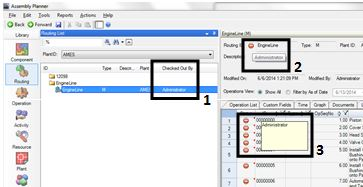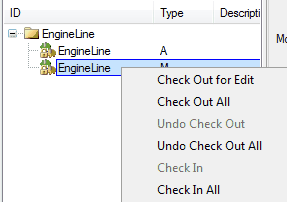What is Check Out/Check In?
Check Out and Check In are features in Assembly Planner designed to prevent multiple users from changing an entity (an item, routing, operation, activity, or resource) simultaneously. To make changes to an entity, it must first be checked out to you; it is not in edit mode until you checks it out. If you check something out, other users can view the information but will be unable to make changes until you check it back in.
For items, changes can only be made to current revisions. Old revisions cannot be checked out. Any time someone checks an entity out/in, Assembly Planner automatically logs that user's name, time, and date of the check out/in. The record can be found in the History tab of the entity.
How does it work?
When you check an entity out, you are checking out a local copy of the database entry. The entry as it was when you checked it out (master copy) is saved in the database until you check your new copy back in. When you check your local copy back in, any modifications you have made are applied in the database, and the global copy is updated. At this point, other users can see the new copy and can check out the entity to make more changes. Creating the master and local copies allows for an "Undo Check Out", which discards all changes made.
When an entity is Checked In, a lock symbol will appear next to it in the search controls and the headers. ![]()
When an entity is Checked Out to you, you will not see any icon next to it in the search controls or headers.
When an entity is Checked Out to another user, you will see a caution symbol next to it in the search controls and the headers. ![]()

Routing checked out to another user and where to find which user checked out the entities.
To see which user has the entity checked out, you can 1) find the Checked Out By column in the search control, 2) hover the cursor over the caution symbol in the header, or 3) hover the cursor over Status cell containing the caution symbol in the Operation or Activity List tabs.
For a list of all checked out processes under a routing or operation, see the Search List section of the editor, which describes the Checked Out Child Processes Report.
For a complete list of all checked out processes, see the reports section of the process editors, which describe the Checked-out Processes Report.

Right click menu in the search control displaying Check In and Check Out options
Check Out for Edit: This will check out the selected entity, allowing you to edit the entity's properties. Only one user at a time can have a given entity checked out, so only one user can edit each entity at a time.
Check Out All: This will check out the selected entity and any entities contained underneath its structure which were checked in to the database when Check Out All was selected. This control does not give you access to processes under the entity that are checked out by other users. Below is a list of what would be checked out, and therefore could be edited, if you select this option for particular entities.
•Routing: Routing + its Operations + Activities of its Operations
•Operation: Operation + its Activities
•Item: Item and its child Items
Undo Check Out: A feature that moves the entity back to its state before the check out. This will check the entity back in, and restore the entity's properties that existed prior to the most recent check out, which cancels changes you made since the entity was checked out. Note: Clicking on the ![]() save icon saves the changes for the local copy, not to the stored master copy. If you choose "Undo Check Out", the stored master copy will be reinstated. Any changes made since then will be lost.
save icon saves the changes for the local copy, not to the stored master copy. If you choose "Undo Check Out", the stored master copy will be reinstated. Any changes made since then will be lost.
Undo Check Out All: This will check back in the entity and all checked out entities underneath it, and restore the entities' properties that existed prior to the most recent check out. Note: Clicking on the ![]() save icon saves the changes for the local copy, not to the stored master copy. If you choose "Undo Check Out", the stored master copy will be reinstated. Any changes made since then will be lost.
save icon saves the changes for the local copy, not to the stored master copy. If you choose "Undo Check Out", the stored master copy will be reinstated. Any changes made since then will be lost.
Check In: Saves the changes to the database. Once an entity is Checked In, all users will see the new changes, and the entity can be checked out by another user. Note: Clicking on the ![]() save icon saves the changes for the local copy. However, the changes are not written to the master copy until it is checked in.
save icon saves the changes for the local copy. However, the changes are not written to the master copy until it is checked in.
Check In All: This will check in the selected entity and any entities contained underneath its structure that were checked out to you, which means that all users will see the new changes, and the entities can be checked out by another user. This control does not give you access to processes that are checked out by other users, and it will not check those processes in.
Checking Out Processes to Edit
Since global properties can be edited without checking out the parent process, several people can work on one routing at a time. Even if the routing is checked out to some user, another user could check out an operation and modify the global properties. This is helpful if several manufacturing engineers are assigned to different portions of the line.
Because of the process structure and dependencies between process levels, there are certain fields that can and cannot be edited when a process or its parent process is checked out. If you are comfortable with the idea of Global and Local Properties, the table below gives you an idea of what process level should be checked out to edit certain properties.
Process Level |
What type of property do you want to edit?* |
What should you check out? |
Routing |
Any |
Routing |
Operation |
Global |
Operation |
Local |
Parent Routing |
|
Activity |
Global |
Activity |
Local |
Parent Operation |
*Some fields cannot be edited once created; see the Standard Fields list.
The table below gives further detail, showing which processes must be checked out to edit certain fields in each process editor.
Editor |
Tab |
Field You Wish to Edit* or Function You Wish to Use |
Process(es) that Must be Checked Out |
Routing Editor |
Routing Header |
Routing Description |
Routing |
Operation List |
Local Operation Properties |
Routing |
|
Custom Fields |
Values |
Routing |
|
Time |
Rollup |
Routing |
|
Update Times |
Routing + All Child Operations and Activities |
||
Graph |
Predecessors |
Routing + All Child Operations and Activities |
|
Documents |
Import, Check Out, Check In, Delete |
Routing |
|
Open, Export, Refresh |
No checkout necessary |
||
History |
Add/Edit |
Routing |
|
Fetch History |
No checkout necessary |
||
Line Balancing Scenarios |
Open, View |
No checkout necessary |
|
Operation Editor |
Operation Header |
Operation Description |
Operation |
Activity List |
Local Activity properties |
Operation |
|
Custom Fields |
Values |
Operation + Parent Routing |
|
Time |
Rollup |
Operation |
|
Update Times |
Operation + All Child Activities |
||
Documents |
Import, Check Out, Check In, Delete |
Operation |
|
Open, Export, Refresh |
No checkout necessary |
||
Ergonomics |
Motions tab is view only |
Operation + All Child Activities |
|
Options tab |
No checkout necessary |
||
Where Used |
Search |
No checkout necessary |
|
History |
Add/Edit |
Operation |
|
Fetch History |
No check out necessary |
||
Activity Editor |
Activity Header |
Activity Description |
Activity |
Properties |
Local activity properties |
Activity |
|
Custom Fields |
Values |
Activity + Parent Operation |
|
Media |
Set default video and image and edit images |
Activity |
|
Time |
All |
Activity |
|
Work Step |
All |
Activity |
|
Resource |
Local resource properties |
Activity |
|
Consumption |
Local item properties |
Activity + Parent Operation |
|
Model-Option Mapping |
ModelID and OptionID |
Activity + Parent Operation |
|
Documents |
Import, Check Out, Check In, Delete |
Activity |
|
Open, Export, Refresh |
No checkout necessary |
||
Where Used |
Search |
No checkout necessary |
|
History |
Add/Edit |
Activity |
|
Fetch History |
No checkout necessary |
*Some fields cannot be edited once created; see Standard Fields list.